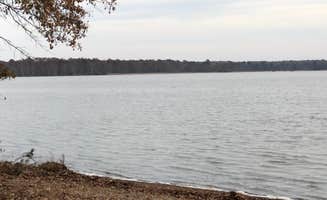Wildlife Management Areas (WMAs) near Charles City, Virginia offer primitive camping options with varied terrain and water access. Located within Virginia's coastal plains at elevations typically under 100 feet, these areas experience hot summers and mild winters, with high humidity throughout most of the year. Many camping spots sit directly alongside the James River and Chickahominy River, where tidal influences affect fishing conditions and shoreline access.
What to do
Fishing from shore: The James River provides productive fishing grounds at Eagle Nest Lookout, where anglers use various techniques. "If you are fishing, they pulled up a 17 pounder and a 25 pounder using a drone to take their lure easy out and someone caught a decent bass," notes one camper who visited during winter.
Hiking local trails: Several unmarked trails wind through the forested areas surrounding campsites. These paths offer opportunities for wildlife viewing, particularly in early morning. "The scenery is spectacular alongside the Chickahominy River and a great place to for hiking," reports a visitor who stayed near the boat ramp area.
Wildlife observation: The 5,217 acres of Chickahominy Wildlife Management Area provide habitat for numerous coastal plain species. Dawn and dusk offer the best viewing opportunities when animals are most active. "There are about 15 cleared areas any one of which I would have been happy with," mentions one camper, noting the multiple vantage points for wildlife spotting.
What campers like
Direct water access: Many campsites allow setting up within feet of the water. "I arrived with a small (18') trailer and put it within 5' of the water," shares one Chickahominy WMA camper, highlighting the premium riverside locations available for those who arrive early.
Elevated camping spots: Some areas feature raised positions overlooking the water. "Car camped here 5 feet from the water. There is a large shoreline area to Car camp and right up the hill is a nice tent site as well overlooking the river," explains a winter camper at Eagle Nest Lookout.
Solitude after daylight hours: While popular with day visitors for fishing, many sites become peaceful in the evenings. "We ended up having the place to ourselves once all the people Fishing left," notes one camper, describing the transition from busy daytime use to quiet nighttime camping at Ware Creek Wildlife Management Area.
What you should know
Permit requirements: Virginia residents with valid fishing or hunting licenses can camp free for up to 14 days. Non-residents must purchase daily passes. "Camping here is free but there is a $4 daily use fee to be in the WMA that you can pay via phone, website or app tho the clunkiness of the website and app make it hard," advises a Chickahominy WMA camper.
Limited site privacy: Some camping areas experience heavy daytime traffic, particularly during peak fishing seasons. "If your looking for complete privacy, I'd recommend trying one of the other sites sprinkled around the area. Definitely a busy little spot," warns one Eagle Nest Lookout visitor.
Noise considerations: The proximity to shooting ranges affects some campsites, especially on weekends. "Be aware that you will be able to hear the shooting range up till the evening. In my opinion these areas are not necessarily the best place for quiet secluded camping," cautions a camper who experienced noise disruptions.
Tips for camping with families
Pack trash bags: Several campers report finding trash at sites. "The site had some trash unfortunately. But the privacy and singularity of canning so close to the water made it a nice find," notes one visitor, suggesting bringing supplies to clean your chosen spot.
Choose elevated sites with children: Higher ground camping areas provide safer alternatives to shoreline spots for families. "At the top is an area about 20 feet wide covered in mature trees with a view of the James River. You are able to park down below and carry your gear the short distance," describes a camper at Eagle Nest Lookout.
Arrive early on weekends: Securing preferred spots requires arriving before afternoon, especially during fishing season. "We arrived and set up camp around 3pm," mentions one camper who was later disturbed by late-arriving visitors engaging in fishing activities nearby.
Tips from RVers
Small trailers only: The access roads and parking areas accommodate modest-sized RVs and trailers. "Basic parking spot in quite location. Weekends some hunters and shooting range close by in other side. It's 2 parking side by water and some other ones on the way while driving," explains a visitor describing the limited parking options.
Level parking challenges: Prepare for potentially uneven terrain when positioning vehicles. "Got here late as the sun was going down. Camped in the RAV4. Will explore the area in the morning," shares a Ware Creek WMA visitor who opted for car camping rather than setting up a traditional site.
Water access for larger vehicles: Some shoreline areas can accommodate small trailers directly alongside the water. "I arrived with a small (18') trailer and put it within 5' of the water," reports a camper, noting the rare opportunity for waterfront RV parking without formal campground facilities.


